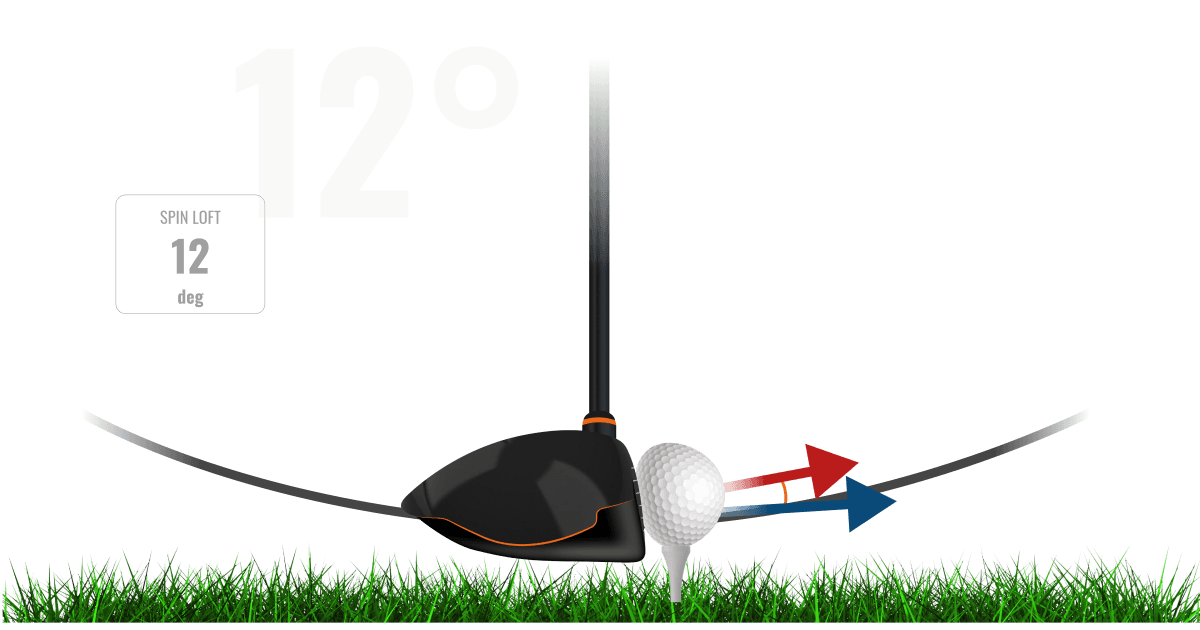What is Spin Loft?


Having an immense influence on Spin Rate, Spin Loft is approximately the angle between the dynamic loft and attack angle
Spin Loft is the three-dimensional angle between the direction the club head is moving (both club path and attack angle) and the direction the club face is pointing (both face angle and dynamic loft).
Simply subtracting attack angle from dynamic loft will give a close approximation of the Spin Loft angle.
However, if the face to path value is not equal to zero, then the simple subtraction method will vary from the actual Spin Loft. The greater the face to path value, the more the subtraction method and actual value will vary.
The spin rate of a shot is largely influenced by the Spin Loft. All else equal, a higher Spin Loft will result in a higher spin rate. Controlling Spin Loft is key to controlling spin rate.
Also, a higher Spin Loft will create a lower smash factor with all else equal. Because of this fact, some will refer to Spin Loft as ‘compression’. A lower Spin Loft creates greater ‘compression’ (and a lower spin rate).
To learn more about Spin Loft, check out Grant Waite and Joseph Mayo explaining how the correct spin loft can help you gain significant distance off the tee.
Technical Definition:
Spin Loft – The angle between the direction of the club head’s center of gravity movement (ATTACK ANGLE and CLUB PATH) and the club face orientation at the center-point of contact between club face and golf ball (DYNAMIC LOFT and FACE ANGLE).
Remark: This angle is calculated between two 3D vectors. Since the difference between CLUB PATH and FACE ANGLE are typically much smaller than the difference between ATTACK ANGLE and DYNAMIC LOFT, the SPIN LOFT is generally very close to DYNAMIC LOFT minus ATTACK ANGLE.
Tour Averages
PGA Tour
Driver = 14.7 degrees
6-iron = 24.3 degrees
LPGA Tour
Driver = 15.0 degrees
6-iron = 25.9 degrees
Trackman Combine Averages
Male Amateur (Driver)
Scratch or better = 14.8 degrees
5 HCP = 15.8 degrees
10 HCP = 17.3
Average Golfer (14.5) = 18.3 degrees
Bogey Golfer = 18.2 degrees
Female Amateur (Driver)
Scratch or better = 17.1 degrees
5 HCP = 18.4 degrees
10 HCP = 18.6 degrees
15 HCP = 20.1 degrees
The standard assumption for Spin Loft comes from the Trackman Optimizer
For the driver, a club speed of 94 mph, attack angle of 0 degrees, and optimized carry results in a Spin Loft of 15.6 degrees
For a 6-iron, a club speed of 80 mph and mid-trajectory results in a Spin Loft of 25.5 degrees
For a PW, a club speed of 72 mph and mid-trajectory results in a Spin Loft of 40.6 degrees
Read what our Trackman University Masters say about Spin Loft…
“Spin Loft is a fantastic parameter when I work with players who are trying to achieve an optimum balance between attack angle and dynamic loft to create continuity of ball flight and distance control throughout the bag. Using Spin Loft helped me to persuade one student to concentrate on reducing the dynamic loft at impact while maintaining their shallow angle of attack. The result was less spin and a higher smash factor that resulted in 18 yards of additional distance on their average drive.”

Chris Brook
PGA International Golf Coach, UK
“I use Spin Loft to see if a player is maximizing the way they are compressing the golf ball. If the ball is spinning too much (or not enough), I will look at Spin Loft to see if the number is in-line with the club they are using. If not, I will look at dynamic loft and attack angle to make sure those numbers are acceptable for the club and type of shot the student is trying to hit.”

Mark Anderson
Philadelphia Cricket Club, PA, US
“Spin Loft directly influences the spin rate so it is an important key to controlling or maximizing distance. When working with accomplished players, I routinely check to make sure they have a consistent Spin Loft with any given club by having them hit a few ‘stock’ shots. Then I like to make sure they can change their Spin Loft on demand from one swing to another. This ability is very important when adapting to the conditions at hand.”

Dom DiJulia
Dom DiJulia School of Golf, PA, US